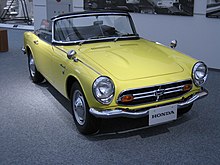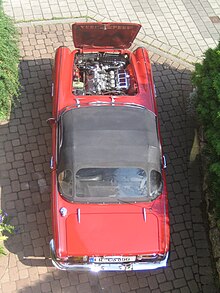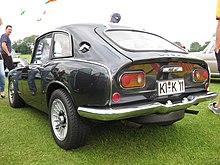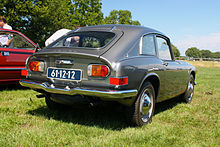Honda S800
The Honda S800 is a convertible or station wagon with a longitudinal front engine and rear-wheel drive from Honda . This sports car was the first Japanese automobile to hit the German market in 1967 and was built in the Suzuka production facility from 1966 to 1970 .
development
The Honda S series began after the pre-production model S360 , with the S500 in August 1963, which came onto the market as a convertible with a water-cooled 500 cm³ engine. The S600 Cabriolet followed in March 1964 and an S600 Coupé in 1965 .
The L800 and P800 from 1966 had a weaker engine than the S800 and were delivery vans (station wagons or flatbed trucks).
Prototypes
The S700 prototype from 1965, with a 687 cc engine and 72 SAE hp at 9500 rpm, was not produced.
The N800 prototype, with a weaker engine from the S800, was presented as a possible sedan at the Tokyo Motor Show in October 1965 , but it was not produced in this form.
idea
At the Paris Motor Show in 1966, Honda presented the S800 to the European public for the first time, then also at the London Motor Show and the Turin Motor Show . It was presented and sold in Japan in January 1966, and is also called Esuhachi there.
In Germany, the S800 was presented to the press in Hamburg on December 6, 1966. At another date on December 10th in Hamburg in the Hall of Nations, Planten un Blomen , the racing driver Hans Herrmann was engaged to promote sales and vehicles were available for test drives. It was exported from October and after the establishment of the dealer network it was also available in Germany from March 21, 1967. With this S800, Honda started out as the first Japanese car manufacturer in Germany in 1966 and was able to sell significant numbers (1967–1970 approx. 1,200). The S800 was also the first Japanese automobile to be tested by “auto, motor und sport” magazine. On the occasion of the type approval measurement by the Federal Motor Transport Authority on the Hockenheimring , Ernst Leverkus , from the “mot” magazine, was able to drive the car.
It was officially only sold in Japan, Australia, France, Germany, Belgium, the Netherlands, England, Italy and Switzerland.
technology
The small water-cooled 791 cc high-performance engine of cast aluminum made a maximum of 67.2 hp (50 kW) at 7570 min -1 and was forward along and 45 degrees to the left about the longitudinal axis is inclined in the engine compartment placed to allow a lower mounting height. The mean piston speed at nominal speed was 17.66 m / s. The liter output of 84.9 hp / l was quite high in a production vehicle for this time. For the bearings of the crankshaft and for the connecting rod bearings , Honda only used needle roller bearings, which in addition to lower friction losses also resulted in fewer lubrication and cooling problems. Four Keihin horizontal constant pressure carburettors (type CVB36N30A1 ) supplied the engine with the mixture. 12 spark plugs type NGK D8ES ( DR8ES-L ) and D9ES were used for touring and D10ES ( DR10ES ) for racing. The firing order is 1-2-4-3 and the valve clearance (inlet and outlet) when the engine is cold is 0.2 mm. According to the operating instructions, the climbing ability is 25% for the convertible and 23% for the coupe.
The power was translated via a synchronized four-speed gearbox. In the first type of the S800 Cabriolet (type code AS800 and product code 516) or coupé (type code AS800C and product code 525), the power was transmitted via a cardan shaft to a differential and via an intermediate shaft and chain on the left and right to the rear wheels. The chain cases with an oil bath were supported on the frame as rockers by coil springs with internal telescopic shock absorbers . The car thus had an independent suspension . Honda retained this construction principle for almost the entire Sports series. Only 752 Cabriolets and 242 Coupes of the S800 were built in four months of this early version.
The S800 was in May 1966 when Mark I, a conventional rigid axle on trailing links and track bar . Exactly 604 cabriolets and 69 coupes were built with this version until the drum brake was replaced by the disc brake on the front axle. From October 1967 this was named Mark II from chassis no. 1005001 built. The front wheels were guided by wishbones and dampened by shock absorbers and suspended by two longitudinal torsion bars that were attached to the frame . The three-spoke steering wheel is made of aluminum and has a handrail ring made of plastic as imitation wood. This sports car was offered in two versions, a convertible and a coupé . The first convertibles were only available in red or white, the coupé in silver gray. The interior with artificial leather seats was always black. Accessories included a radiator cover, cigarette lighter, inspection lamp, armrest (convertible), front passenger sun visor, bumper horns, plastic hardtop (convertible), pannier rack (convertible) and tarpaulin (convertible). The taillights of the first S800 MK II, which was sold in Germany in 1967, only got approval from the German TÜV after 2x2 round German HELLA taillights were attached. The round reflectors were attached separately. The version of the Japanese rear light, with indicators and a reversing light + reflector integrated in the middle, were only two-chamber lights.
In February 1968 the S800 Mark II from engine no. 1007638 (type code AS800A and product code 531 + 542) produced and presented. It now had a dual-circuit brake system , a carburetor with an acceleration pump (type 1000-338-00), recessed interior door handles and openers, and the indicators placed in the front grill were elongated and larger. The rear light units as three-chamber lights, with the rear light / indicator light + brake light (yellow) and reversing light placed side by side, were now the same in all national versions. The front and side windows were made of laminated glass for safety reasons and the heating was more powerful. In Germany, according to the brochure, the convertible was available in red, white and yellow, the coupé in red, white, yellow, silver and later also in gold metallic or bronze. The last coupes to be delivered in 1970 were all yellow. A radio was only installed in the Japanese version. Under the designation S800M , Honda upgraded the car with a view to the American market. Side indicators with reflectors were an outward appearance feature. However, Honda failed because of the relatively strict US emissions laws.
In connection with the engine, there was a curious incident: After Honda stated that the engine because of its needle-bearing crankshaft easily a speed of 10,000 min -1 would stand, the Technical University of Braunschweig tested this on their bench. It increased gradually the speed until it at 12,000 min -1 was a loud bang. However, it had not dismantled the engine, but the test bench. At least that's how it is passed down. The enormous speed stability of the motor, which was unparalleled at the time, is undisputed.
The S800 in motorsport
May 3, 1964: In a prelude to the 2nd Grand Prix in Suzuka, the American racing driver Ronnie Bucknum won in the GT-I class up to 1000 cm³ with a white factory-supported S600 convertible with a red hardtop (No. 15) and came through it as a driver in the Honda Formula 1 racing team. The international racing debut was opened by New Zealander Denis Hulme , who later became Formula 1 world champion ( 1967 ), on September 6, 1964 at the 500 km race on the Nürburgring . With a white S600 convertible / hardtop Gran Turismo - sports car (no. 88) cc with around 630 capacity had to take the handicap upon himself to start cc in the Gran Turismo class to 1000. He won in this class with an average of 106.3 km / h.
May 28, 1967: Team Barracuda, with drivers Carl Smet / Hughes de Fierlant , won the ADAC 1000 km race on the Nürburgring in the Gran Turismo class up to 1000 in a yellow S800 Coupé (No. 125) cm³. They drove the 34 laps in 7: 04.26.4 hours or at an average speed of 109.8 km / h.
September 3, 1967: The Japanese Tetsu Ikuzawa won with a white S800 RSC Cabrio / Hardtop (No. 58) in the 500 km race on the Nürburgring in the Gran Turismo class up to 1000 cm³ and was faster than the winner of the class the sports car up to 1600 cm³. He drove the 20 laps in 3: 45.17.8 hours, average speed 121.6 km / h. For the fastest lap he needed 11.04.0 min, an average of 123.8 km / h. The engine is said to have delivered 108 hp (79 kW).
August 4, 1968: The winners of the GT-1 class at the 12-hour race in Suzuka were the Japanese drivers Kuniomi Nagamatsu / Yoshifumi Kikura with a yellow S800 RSC convertible / hardtop (No. 25), which with 872.8 cm³ approx . 108 hp (79 kW) at 10,500 min -1 made. They took third place in the field with racing vehicles up to 3000 cm³.
From April 1967 there was a complete S800 Racer with a homologated competition kit developed by the factory for three times the price of the basic model. The curb weight was reduced to 695 kg, the bumpers and the unnecessary parts were removed. The vehicle had a fixed hardtop, a roll bar and magnesium alloy wheels. The 818 cm³ engine had a lighter crankshaft and a Keihin racing carburetor without an air filter. The power increased to 90 hp (66 kW) at 9500 min -1 . This power was transmitted via an unsynchronized five-speed gearbox. The top speed was around 180 km / h. Only a dozen of these racing models came to Europe, half of them to France, where the car was also shown in a sales brochure. One of the vehicles can be viewed today in the Classic Race Museum near the Nürburgring. Another S800 RSC -Honda, yellow with three red stripes and the start number. 25, is in the Honda Museum in Motegi, Japan.
successor
With the introduction of the Roadster S2000 in 1999, Honda revived the old sports car tradition. The name cannot be denied that they are closely related, the technology and speeds are similar.
Model overview
| S360 prototype | S500 | S600 | S800 | |

|

|
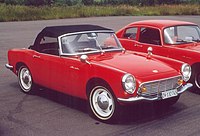
|

|
|
| Technical specifications | ||||
| engine | In-line four-cylinder four-stroke engine (light metal), water-cooled, DOHC , 4 Keihin horizontal throttle valve carburettors |
|||
| Displacement | 356 cc | (492 cm³) 531 cm³ | 606 cc | 791 cc |
| Bore × stroke | 49 × 47 mm | 54 × 58 mm | 54.5 × 65 mm | 60 × 70 mm |
| compression | 9.5: 1 | 9.5: 1 | 9.5: 1 | 9.2: 1 |
| power | 33 horsepower at 9000 min -1 | 44 horsepower at 8000 min -1 | 57 horsepower at 8500 min -1 | 67.2 hp (49 kW) at 7570 min -1 |
| Max. Torque ( SAE ) | 26.5 Nm at 7000 min -1 | 37.3 Nm at 8000 min -1 | 51 Nm at 5500 min -1 | 68.6 Nm at 5800 min -1 |
| Carburetor | Solex Mikuni BSW28 | KEIHIN CVB 31-26-1 / RP 35-29P-40 | KEIHIN CVB 31-26-1 | KEIHIN CVB 36N-30-A1 / from 1968 = 1000-338-00 |
| Engine weight | ? | 118 kg | 102 kg | 105 kg |
| body | Ladder frame with all-steel body | |||
| Front landing gear | Independent suspension with wishbone , torsion bar , shock absorber , stabilizer | |||
| Rear landing gear |
Independent wheel suspension with chain box swing arms and coil springs, telescopic shock absorbers |
Rigid axle , trailing arm , Panhard rod , coil springs |
||
| Length × width × height (mm) | 2990 × 1295 × 1146 | 3195 × 1295 × 1146 | 3300 × 1400 × 1200 | 3335 × 1400 × 1215 |
| Wheelbase (mm) | (TAS260 = 1950) 2000 | 2000 | 2000 | 2000 |
| Ground clearance (mm) | 160 | 160 | 160 | 160 |
| Standard tires | 5.20-12 2PR | 5.20-13 | 5.20-13 4PR | 145 or 155 SR13 |
| Turning circle | 8.4 m | 8.6 m | 8.6 m | 8.8 m |
| Empty weight | 510 kg | 725 kg | 720 kg
(730 kg Coupé) |
740 kg
(755 kg coupé) |
| Top speed | over 120 km / h | over 130 km / h | 145 km / h | 160 km / h |
| Acceleration 0-100 km / h | approx. 20 s | approx. 18 s | 13.8 s
(13.9 s Coupé) |
13.7 s |
| Tank capacity | 25 liters | 25 liters | 30 liters | 35 liters
(30 liter coupé) |
|
consumption
(Super Plus 98 RON ) |
5 l / 100 km at 90 km / h | 5 l / 100 km at 100 km / h | 5.3 l / 100 km at 100 km / h | 8 l / 100 km at 110 km / h |
| Factory price | not on sale | 459,000 yen
(Japan only) |
509,000 yen
(Japan) |
7750 DM
(1967) |
| Production time | 1961-1963 | Oct. 1963 – Sept. 1964 | March 1964–1966 | Jan. 1966 – May 1970 |
| production
(Number of pieces) |
12 Cabriolet | 1353 | 13,084 | 11,523 |
Production summary table
| S500 convertible | S600 convertible | S600 coupe | S800 convertible | S800 coupe | Total number of pieces | |
| 1963 | 136 | 136 | ||||
| 1964 | 1227 | 3912 | 5139 | |||
| 1965 | 7261 | 1519 | 11 | 8th | 8799 | |
| 1966 | 111 | 281 | 1734 | 539 | 2665 | |
| 1967 | 888 | 4248 | 5136 | |||
| 1968 | 990 | 2291 | 3281 | |||
| 1969 | 147 | 509 | 656 | |||
| 1970 | 15th | 143 | 158 | |||
| number of pieces | 11284 | 1800 | 3785 | 7738 | ||
| total | 1353 | 13084 | 11523 | 25,960 | ||
Vehicle inventory
In Europe, around 7200 copies of the S800 were sold within 4 years, 1200 of them in Germany. According to research by HTCR_Honda_Twin_Cam_Register / USA from December 2012, there are still around 284 copies of the S800 with 113 convertibles and 171 coupés in all conditions, around half in running order.
In Japan, around 12,000 vehicles of the S500, S600 and S800 were sold, of which around 2,800 were still owned by enthusiasts in 1978.
The S800 in the media (selection)
- In many of their adventures in the comic series Spirou & Fantasio , the title characters drive a white S800 convertible reproduced in great detail by the illustrator André Franquin .
- The 1982 French film La Boum 2 (Die Fete) features a white S800 Coupé.
- In the French / German film "Die Zweigeteilte Frau", original title: La fille coupée en deux from 2007, a leading actor drives a silver S800 coupé. The film is by old master Claude Chabrol .
Quotes
“The Honda S800 is an unusually inexpensive automobile; where else can you get a real two-seater sports car for less than 8,000 marks. The fact that the Honda is a real sports car and not just looks is proven by its good performance and an engine that is seldom found. Since the workmanship and quality also meet good European standards, its sales success can hardly be avoided in the long term. After all, it offers sporty driving characteristics and highly developed engine technology at an extremely low price. "
literature
- Unknown author: S800 Service Guide. HONDA MOTOR CO., Japan May 1971. (English)
- Unknown author: HONDA SPORTS. creative boutique Neko, Japan 1978. (Japanese)
- Jürgen Lewandowski: HONDA AUTOMOBILES. Südwest Verlag, Munich 1988, ISBN 3-517-01078-2 .
- Shigeru Miyano et al .: HONDA SPORTS S 360-S800M. MIKI Publishing House, Japan 1990, ISBN 4-89522-141-5 . (Japanese)
- various authors: THE PURSUIT of DREAMS. Car Graphic Japan, 1998, ISBN 4-544-04060-4 . (English version)
Web links
Individual evidence
- ↑ THE PURSUIT of DREAMS , Car Grahic Japan, from 1998, ISBN 4-544-04060-4 , English edition, p. 34.
- ↑ THE PURSUIT of DREAMS , Car Grahic Japan, 1998, ISBN 4-544-04060-4 , English edition, p. 35
- ↑ Motor Klassik , issue 6/1986, p. 39.
- ↑ Auto, motor und sport , issue 14/1967, p. 32.
- ↑ mot , issue 21/1966, p. 9.
- ↑ THE PURSUIT of DREAMS , Car Grahic Japan, from 1998, ISBN 4-544-04060-4 , English edition, p. 36.
- ↑ auto, motor und sport , issue 20/1964.
- ↑ auto, motor und sport , issue 12/1967, p. 42.
- ↑ rallye & racing , issue 10/1967, p. 42.
- ↑ JAPANESE AUTOMOBILES 133 pages, Heel Verlag, 2007, ISBN 978-3-89880-824-8 , p. 123.
- ↑ HONDA AUTOMOBILE 170 pages, Südwest Verlag, from 1988, ISBN 3-517-01078-2 , partly from page 156 + 157
- ↑ Sports360 Production, mizma-g.cocolog-nifty.com from 2007, Japanese
- ↑ HONDA SPORTS JOURNAL , annual edition No. 10 from 1983, p. 36.
- ↑ HONDA SPORTS , creativeboutique Neko 1978, p 35, Japanese
- ↑ quoted from auto motor und sport , issue 14/1967
